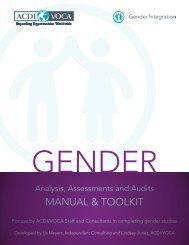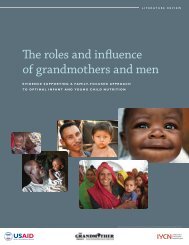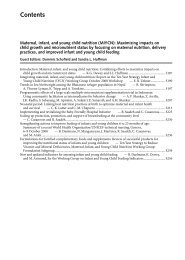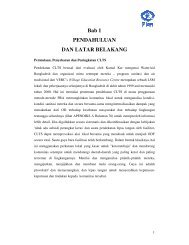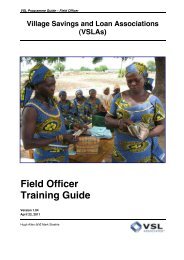Module 2. Theorethical Concepts of Gender - FSN Network Portal
Module 2. Theorethical Concepts of Gender - FSN Network Portal
Module 2. Theorethical Concepts of Gender - FSN Network Portal
You also want an ePaper? Increase the reach of your titles
YUMPU automatically turns print PDFs into web optimized ePapers that Google loves.
Mainstreaming <strong>Gender</strong> into Water, Sanitation and Hygiene (WASH) Programs<br />
<strong>Module</strong> 2: Theoretical <strong>Concepts</strong> <strong>of</strong> <strong>Gender</strong><br />
Lesson 7: <strong>Gender</strong> <strong>Concepts</strong> (2): <strong>Gender</strong> Roles and Relationships and <strong>Gender</strong> Needs<br />
there should be two examples <strong>of</strong> non-traditional work for women and<br />
men and two examples <strong>of</strong> traditional work for women and men.<br />
5 Ask each group to list down on a flipchart the things that are needed by<br />
women and men to perform the respective roles shown in the<br />
photographs.<br />
6 Ask one participant from each group to show their photograph to the<br />
whole group and then to present their group work.<br />
7 While the groups are presenting, note down on a flipchart with two<br />
different-coloured markers the two types <strong>of</strong> gender needs they mention<br />
– practical gender needs (PGNs) and strategic gender needs (SGNs) –<br />
out <strong>of</strong> participants’ line <strong>of</strong> sight.<br />
8 Using the material in Handout 7.3: Definitions <strong>of</strong> <strong>Gender</strong> Needs explain<br />
the two kinds <strong>of</strong> gender needs in detail, giving examples <strong>of</strong> both. Help<br />
participants to understand that when any man wants to share the<br />
responsibilities <strong>of</strong> women, he may also face social constraints.<br />
9 Show the flipchart where you have summarised the two types <strong>of</strong> needs<br />
from their group work and thus relate participants’ practical experience<br />
with the two types <strong>of</strong> needs.<br />
10 Tell the participants, by giving examples, that practical gender needs<br />
are related to the condition <strong>of</strong> men and women, and strategic gender<br />
needs are related to their position.<br />
11 Summarise the session, mentioning again the two types <strong>of</strong> gender<br />
needs, and distribute the Handouts.<br />
12 Show participants the objectives <strong>of</strong> the session again, check that these<br />
have been achieved and answer any further questions.<br />
Review<br />
1 Ask one male and one female participant to give one example <strong>of</strong><br />
practical gender needs and one <strong>of</strong> strategic gender needs.<br />
2 Summarise the session by showing participants the learning outcomes<br />
and checking if participants consider that these have been achieved.<br />
Learning Outcomes for Participants<br />
1 Participants will be able to identify the two types <strong>of</strong> gender needs.<br />
2 Participants will be able to analyse and relate gender needs to their<br />
own life and work.<br />
A Training Manual for Water Pr<strong>of</strong>essionals developed collaboratively by PROTOS and SNV, 01/02/2007<br />
<strong>2.</strong>39



